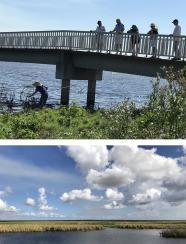当前位置:
X-MOL 学术
›
Ecol. Eng.
›
论文详情
Our official English website, www.x-mol.net, welcomes your
feedback! (Note: you will need to create a separate account there.)
Investigating sources and transformations of nitrogen using dual stable isotopes for Lake Okeechobee restoration in Florida
Ecological Engineering ( IF 3.9 ) Pub Date : 2020-08-01 , DOI: 10.1016/j.ecoleng.2020.105947 Pei Ma , Li Zhang , William J. Mitsch
Ecological Engineering ( IF 3.9 ) Pub Date : 2020-08-01 , DOI: 10.1016/j.ecoleng.2020.105947 Pei Ma , Li Zhang , William J. Mitsch

|
Abstract An analysis of nitrate concentrations and isotopic compositions was undertaken on Florida's large (1730 km2) and shallow (mean depth 2.7 m) Lake Okeechobee to determine possible connectivity between the lake's many inflows and outflows and to illustrate how stable isotopes can assist in the restoration of a very large subtropical lake. The Kissimmee River, as expected, dominated inflows to Lake Okeechobee (58.4 ± 2.11 m3/s) much higher than the second most important inflow, Fisheating Creek, (9.2 ± 0.27 m3/s).The primary outflows (which are sometimes inflows) are the Caloosahatchee (27.7 ± 0.63 m3/s), which flows westward to the Gulf of Mexico and the St. Lucie River (6.98 ± 0.30 m3/s) that flows eastward to the Atlantic Ocean. Water samples of inflows and outflows were collected at 14 locations around the lake in both the dry and wet seasons in 2018. Total nitrogen and total phosphorus averaged 1.56 ± 0.42 mg L−1 and 0.11 ± 0.06 mg L−1 respectively with no significant seasonal variations. Dissolved organic nitrogen (DON = TKN-NH4+) was the dominant form of nitrogen at all sampling sites, with an average value of 1.18 ± 0.32 mg L−1. The TN:TP ratios were mostly less than 22:1. Isotope δ15N-NO3− ranged from −8.75 to 9.14‰, and δ18O-NO3− from −0.26 to 11.97‰. Inflow δ15N-NO3− and δ18O-NO3− measurements ranged from −3.92 to 9.14‰ and 0.50 to 11.97‰. A Bayesian mixing model output revealed that non-point sources from NH4+ fertilizers and soil nitrogen were the main nitrate sources in Lake Okeechobee. NH4+ fertilizer contributes 36.7% of nitrate in the dry season and 54.9% in the wet season, while soil N contributes 31.4% in the dry season and 25.1% in the wet season. Although pasture is the dominant land use in the watershed of Lake Okeechobee, manure was not the dominant source of nitrate; it contributes only 12.0% of the nitrate in the wet season and 25.4% in the dry season. Isotopes of NO3− suggested that denitrification was strong, and nitrification was weak in both the dry and wet seasons. High levels of NH4+ during the wet season, partly caused by weakness of nitrification, promoted uptake of NH4+ that affects microbial food web recycling processes in the lake. These results indicate that monitoring and regulatory strategies for the lake restoration should consider the control of nitrogen pollution sources from agriculture to complement the control of phosphorus inflows that are thought to be the main drivers for harmful algal blooms in the lake and downstream of the lake.
中文翻译:

在佛罗里达州奥基乔比湖修复中使用双稳定同位素调查氮的来源和转化
摘要 对佛罗里达州大 (1730 km2) 和浅水 (平均深度 2.7 m) 奥基乔比湖的硝酸盐浓度和同位素组成进行了分析,以确定该湖的许多流入和流出之间可能存在的连通性,并说明稳定同位素如何有助于恢复一个非常大的亚热带湖泊。正如预期的那样,基西米河主导了奥基乔比湖的流入量 (58.4 ± 2.11 m3/s),远高于第二重要的流入量 Fisheating Creek (9.2 ± 0.27 m3/s)。主要流出量(有时是流入量)是向西流入墨西哥湾的 Caloosahatchee (27.7 ± 0.63 m3/s) 和向东流入大西洋的圣露西河 (6.98 ± 0.30 m3/s)。2018年旱季和雨季在湖周围14个地点采集进出水水样。总氮和总磷平均分别为1.56±0.42mg L-1和0.11±0.06mg L-1,无明显季节性变化。溶解的有机氮 (DON = TKN-NH4+) 是所有采样点的主要氮形式,平均值为 1.18 ± 0.32 mg L-1。TN:TP 比率大多小于 22:1。同位素 δ15N-NO3− 范围为 -8.75 至 9.14‰,δ18O-NO3− 范围为 -0.26 至 11.97‰。流入 δ15N-NO3− 和 δ18O-NO3− 测量值范围为 -3.92 至 9.14‰ 和 0.50 至 11.97‰。贝叶斯混合模型输出显示,来自 NH4+ 肥料和土壤氮的非点源是奥基乔比湖的主要硝酸盐来源。NH4+ 肥料在旱季贡献了 36.7% 的硝酸盐和 54%。9% 在雨季,而土壤 N 在旱季贡献 31.4%,在雨季贡献 25.1%。尽管牧场是奥基乔比湖流域的主要土地利用方式,但粪便并不是硝酸盐的主要来源;它在雨季仅贡献 12.0% 的硝酸盐,在旱季贡献 25.4%。NO3− 的同位素表明反硝化作用强,硝化作用在旱季和雨季都很弱。雨季高浓度的 NH4+,部分是由于硝化作用较弱,促进了 NH4+ 的吸收,从而影响了湖中微生物食物网的循环过程。
更新日期:2020-08-01
中文翻译:

在佛罗里达州奥基乔比湖修复中使用双稳定同位素调查氮的来源和转化
摘要 对佛罗里达州大 (1730 km2) 和浅水 (平均深度 2.7 m) 奥基乔比湖的硝酸盐浓度和同位素组成进行了分析,以确定该湖的许多流入和流出之间可能存在的连通性,并说明稳定同位素如何有助于恢复一个非常大的亚热带湖泊。正如预期的那样,基西米河主导了奥基乔比湖的流入量 (58.4 ± 2.11 m3/s),远高于第二重要的流入量 Fisheating Creek (9.2 ± 0.27 m3/s)。主要流出量(有时是流入量)是向西流入墨西哥湾的 Caloosahatchee (27.7 ± 0.63 m3/s) 和向东流入大西洋的圣露西河 (6.98 ± 0.30 m3/s)。2018年旱季和雨季在湖周围14个地点采集进出水水样。总氮和总磷平均分别为1.56±0.42mg L-1和0.11±0.06mg L-1,无明显季节性变化。溶解的有机氮 (DON = TKN-NH4+) 是所有采样点的主要氮形式,平均值为 1.18 ± 0.32 mg L-1。TN:TP 比率大多小于 22:1。同位素 δ15N-NO3− 范围为 -8.75 至 9.14‰,δ18O-NO3− 范围为 -0.26 至 11.97‰。流入 δ15N-NO3− 和 δ18O-NO3− 测量值范围为 -3.92 至 9.14‰ 和 0.50 至 11.97‰。贝叶斯混合模型输出显示,来自 NH4+ 肥料和土壤氮的非点源是奥基乔比湖的主要硝酸盐来源。NH4+ 肥料在旱季贡献了 36.7% 的硝酸盐和 54%。9% 在雨季,而土壤 N 在旱季贡献 31.4%,在雨季贡献 25.1%。尽管牧场是奥基乔比湖流域的主要土地利用方式,但粪便并不是硝酸盐的主要来源;它在雨季仅贡献 12.0% 的硝酸盐,在旱季贡献 25.4%。NO3− 的同位素表明反硝化作用强,硝化作用在旱季和雨季都很弱。雨季高浓度的 NH4+,部分是由于硝化作用较弱,促进了 NH4+ 的吸收,从而影响了湖中微生物食物网的循环过程。











































 京公网安备 11010802027423号
京公网安备 11010802027423号